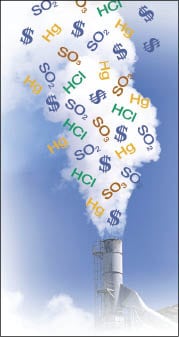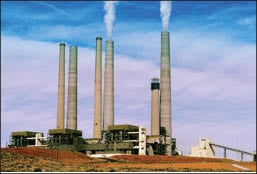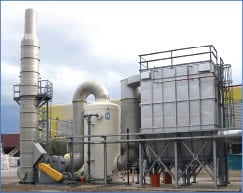 |
| Figure 1. Experts anticipate the new EPA standards regarding SO2 will likely increase capital and engineering costs SOLVAir Solutions
|
Last June, the U.S. Environmental Protection Agency (EPA; Washington, D.C.) strengthened the primary National Ambient Air Quality Standard for sulfur dioxide by establishing a new one-hour standard at a level of 75 parts per billion (ppb). Previous primary standards permitted 140 ppb evaluated over 24 h. While the revised standard is expected to yield health benefits valued between $13 and 33 billion, pollution abatement experts anticipate a variety of challenges for chemical processors who will need to comply with this tighter standard once it makes its way into enforceable state regulations (see box below).
“A significant reduction of the time period for SO2 emissions averaging could affect the type of technology a customer may need to use, as well as its capital and operating costs and the scrubber system’s footprint in the plant,” says Rich Staehle, vice president of business development and technology with Marsulex Environmental Technologies (Lebanon, Pa.).
For example, in the past, when a facility had a wet or semi-dry scrubber system, it was common to have three 50% or four 33% scrubber vessels so that a spare was available to quickly go into operation as needed. But due to the better equipment and technologies available and improved operating procedures in later years, the trend toward this vessel redundancy disappeared. “Many newer facilities may currently have only one scrubber vessel on any particular source,” says Staehle. “But if we narrow the time averaging window we may, in some cases, ultimately have to revert back to redundancies to the extent that we had 30 years ago.”
Maintenance might be another issue. “The configuration and type of equipment installed will determine how much of a challenge a facility might have in consistently achieving an acceptable one-hour average,” Staehle notes. For example, technologies that employ reagent atomizers, which require cleaning, replacement and other periodic maintenance, may have some difficulty in meeting the narrower averaging periods. This type of online atomizer work has commonly been accommodated by operational procedures if the averaging period is sufficient. One of these methods, for example, is to over-scrub, (meaning more SO2 is removed than normal) both before and after the atomizer maintenance, so that the overall SO2 emission levels would remain at an acceptable value over the time averaging period.
“When you have a moderate time-average period to meet, consistent compliance is very achievable because an atomizer can generally be pulled in and out of service within about an hour,” says Staehle. “However, making compliance at the significantly narrower window may be difficult for many existing systems that were designed for the rules at the time of their original installation, and many such systems may require major upgrading or retrofits, or both, to meet one hour averaging. For systems yet to be installed, narrow time average windows will almost certainly compel people to re-evaluate the type of equipment they may be contemplating for SO2removal,” he says.
Equipment selection
While all types of SO2 abatement technology are capable of effectively removing SO2 to acceptable levels, there are definite pros and cons associated with each method, according to the experts.
 |
Dry sorbent injection technologies offer relatively low capital costs and quick installation that can be done off-line, but the cost of sorbents is high, says Mike Wood, business manager with Solvay Chemicals’ SOLVAir Solutions (Houston). “The cost of the sorbents are higher than the operating costs of other technologies, but the capital investment is orders of magnitudes of difference, so there’s a trade off,” he says. There are, however, benefits that might outweigh the higher operating cost. For instance, Wood says dry injection achieves higher levels of removal, and there is a lot of flexibility. When higher levels of SO2 are still acceptable, Solvay’s Trona, a mined, natural mineral, can be used; but when lower levels of SO2 are required, the systems can accommodate sodium bicarbonate, which is a manufactured product with a higher purity and a greater reactivity.
Another option would be to take the sorbent and grind or mill it to a very fine product. Smaller particles provide better distribution and faster reaction of product, so when you need more removal, the product can be milled down further or process improvements can be made by installing a mechanical milling operation right on the process.
“Performance can always be enhanced with dry injection technologies,” says Wood. “When you’re trying to get down to low, low levels, it’s no longer chemistry, it’s physics. You can always enhance this type of process instead of ripping it out,” he says. “This provides the flexibility to do good enough now and better later, which is an attractive option for many processors.”
Likewise, Tri-Mer Corp. (Owosso, Mich.) offers a dry technology that is suitable for high temperatures. The UltraTemp filtration technology uses a caustic calcium- or sodium-based sorbent that is impinged on a rigid ceramic filter that collects particulate and neutralizes SO2 simultaneously, according to John Pardell, president of Tri-Mer. SO2 removal is typically 90% or better with removal efficiencies as high as 97% for this system, which must have an operating temperature within 350–1,000°F for SO2 removal.
Tri-Mer also offers wet technologies like a packed bed scrubber that scrubs SO2 with sodium hydroxide. The device has a recirculation vessel built into the bottom as well as a packed section over which a caustic solution is circulated to neutralize the SO2. Just as operation of a dry system can be tweaked to enhance performance, it is possible to make changes and adjustments to a wet system. “You can increase the concentration of the caustic, increase the depth of the packing in the media, increase the recirculation rate and modify the device to increase the performance beyond the original design,” says Pardell.
Met Pro Environmental Air Solutions (Owosso, Mich.), a group that combines the resources and technology of the company’s three operating units: Duall, Flex Kleen and Systems, also suggests wet scrubber technologies as the optimal solution to the one hour rule. “When levels need to be brought down lower, a second packed scrubber can be added in a series, or modifications can be made to the operating parameters by increasing liquid rates, adding additional packing to the tower or changing to a more efficient packing design in the tower to enhance the performance as needed,” says Steve George, industrial sales manager.
However, Marsulexs Staehle suggests that an alternative semi-dry, multi-pollutant technology — a circulating fluid bed scrubber that has been widely used in China and Europe — might be a good way to meet stricter SO2 guidelines for many sources. A version of this, marketed by MET as the CFB-FGD (circulating fluid-bed, fluegas-desulfurization) technology, employs multi-stage humidification, which injects humidification water at multiple levels, separate from the reagent, into the absorber vessel. This scrubbing approach does not make use of reagent atomizers, so it eliminates the issue of trying to maintain one-hour emission-averaging levels, says Staehle.
Another technological alternative might be DuPont’s Lbbsorb Regenerative SO2 Scrubbing System, which removes SO2 from a gas flow for emission control, while minimizing the costs of wet scrubbing. It also nearly eliminates scrubber-water discharge normally associated with wet scrubbing systems.
With this process, the scrubbing reagent is regenerated for reuse, while at the same time recovering a high-concentration stream of SO2 (90+%) as a byproduct for use in other processes. The recovered SO2 can be used as an additional process feed for existing sulfur recovery units, as well as sulfuric acid plants. With further processing, it can be sold as commercial-grade liquid SO2, sulfuric acid or elemental sulfur.
“With all the technologies available, processors have the ability to really do their homework and find the solution that will work best in their facility while meeting the tighter requirements,” notes Staehle. “There is still time to figure out what you’re doing with your plant and time to figure out how to do it in a way that works best for you.”
